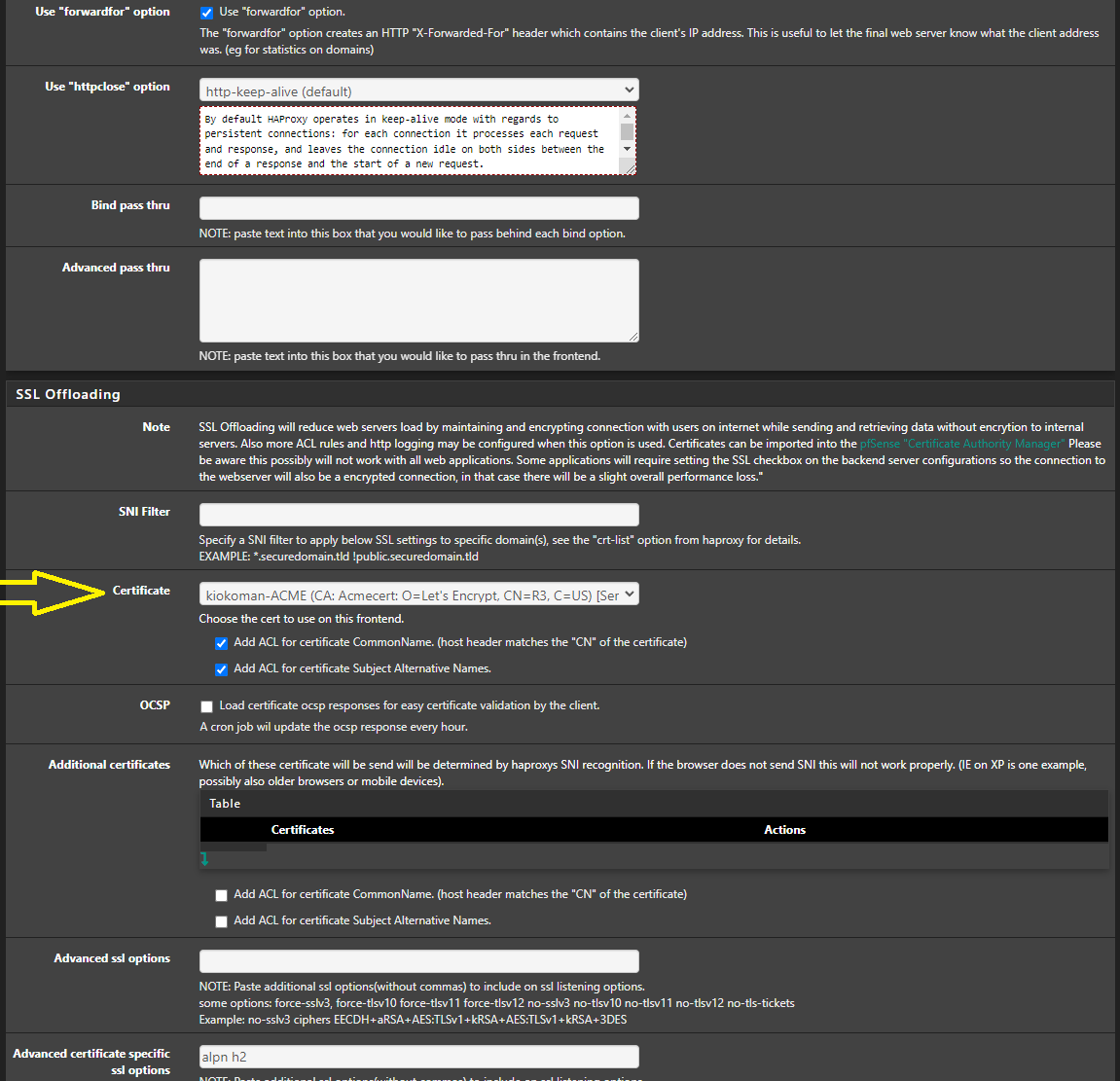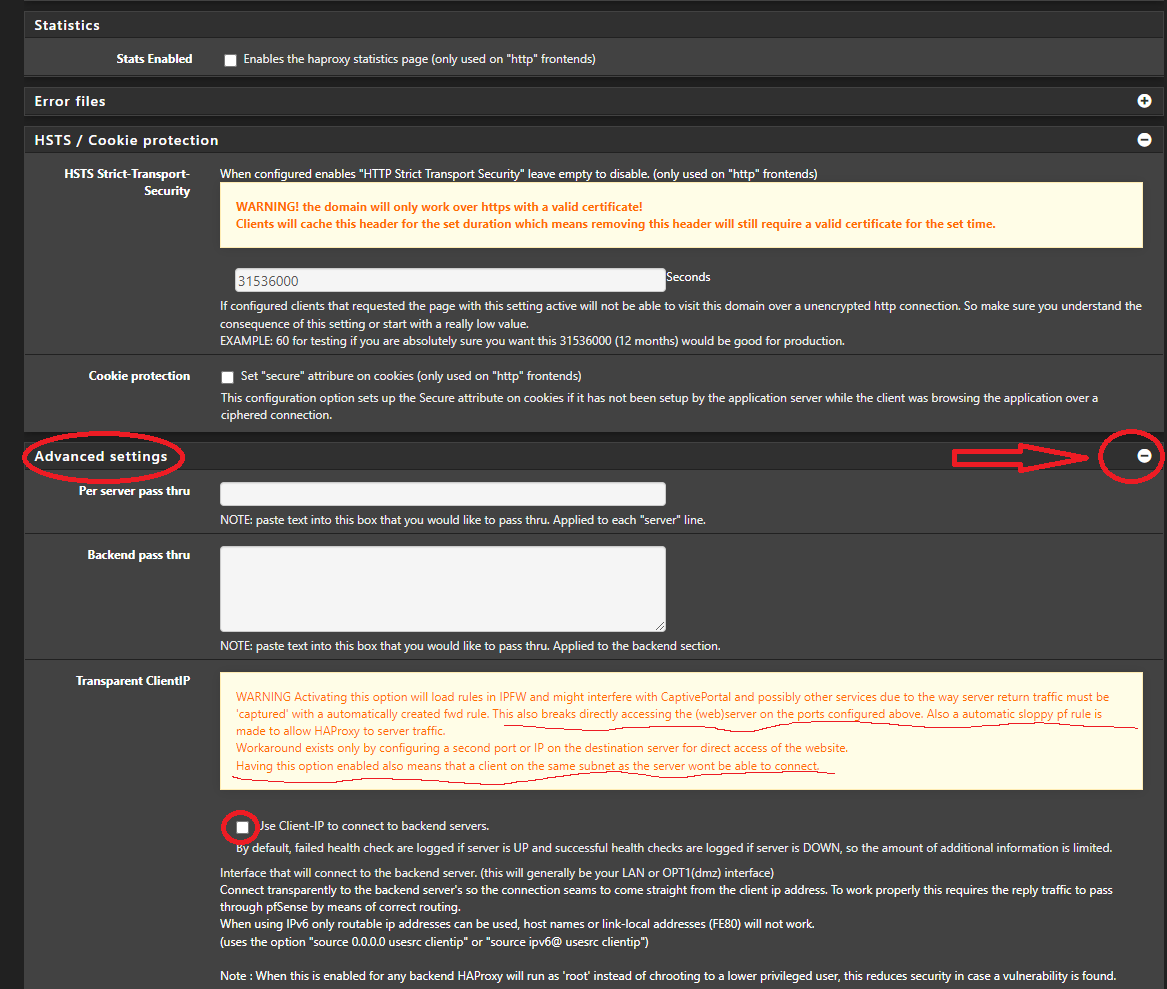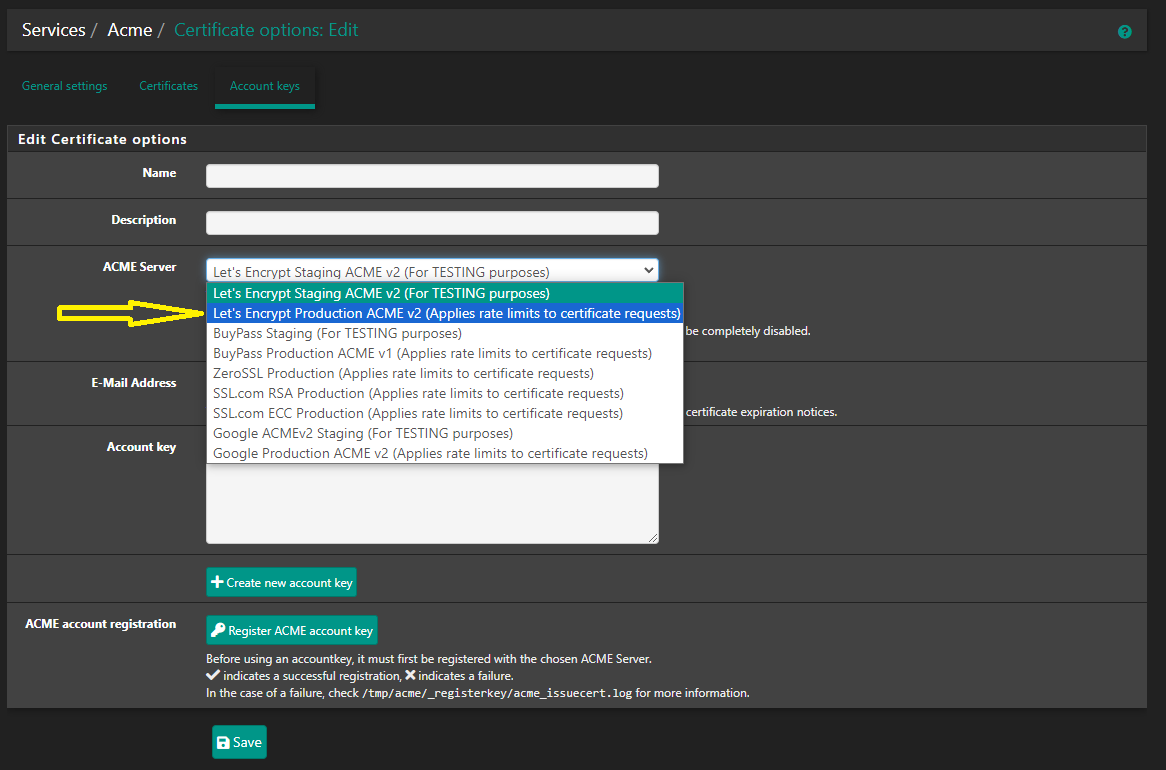SSL certs handling and HAproxy
-
Aha! OK then that's the first hurdle. The client is connecting to HAProxy at least.
So you need to renew the cert now it's set to the production server.
Then see what is broken next.

-
Ok, I've renewed it and no change. Still shows as staging even though I've changed it to production.
The one difference however is now I'm seeing connections to the web server but all of them are getting a 301.The bad thing about doing this is if all I'm going to see are connections from the pfsense device IP, that's going to remove all logging data that is always needed to better understand traffic and so on.
TOR still gets an HSTS error and firefox is still complaining "Warning: Potential Security Risk Ahead".
SSL test still shows;
New, TLSv1.3, Cipher is TLS_AES_256_GCM_SHA384 Server public key is 2048 bit Secure Renegotiation IS NOT supported Compression: NONE Expansion: NONE No ALPN negotiated Early data was not sent Verify return code: 20 (unable to get local issuer certificate)I'm not convinced the problem is with the web server because if I set up a NAT rule again, then it works fine.
This implies there is still something on ACME or haproxy that is not allowing the SSL cert to be used properly.Could it have something to do with how the cert is being generated by ACME since there seems to be some small mismatch between the host/hostname/domain or something and the ACME cert being generated.
There are no errors when ACME renews the cert, all green, all confirmed, looks correct.
-
I wonder if it has something to do with the fact that the cert is being handled by ACME but once the browser hits the web server, that has it's own self signed cert so maybe a mismatch?
However, I cannot fire up the service without a cert if I allow https connections so added teh self signed cert.
Why is this so complicated? No wonder I wasn't able to follow any article I could find to get this working. -
Weird, searching online for help on this leads to so many things but mostly, our own thread now.
I cannot find anything that helps me to solve this. -
One thing I notice is that even with the 'production' setting, the re-generated cert always shows staging;
issuer=C = US, O = (STAGING) Let's Encrypt, CN = (STAGING) Artificial Apricot R3When I re-issue and it shows the green page, there is no mention of staging anywhere.
It's nuts how many articles contradict each other when trying to find anything on this.
-
so you have registered for production
now you should see something with Issuer
Acmecert: O=Let's Encrypt, CN=R3, C=US
under system / certificates /certificates
if you see it than you need to go to haproxy and change, under ssl offloading , the certificate

-
Holy crap, I finally got it working.
I don't even know where to start to show what I did because I tried so many things.
The last thing I did was in the backend, changing the server list Table from port 80 to port 443 and enabling Encrypt(SSL).The main problem I have now is still not knowing what the correct configuration of the web server should be.
It's using a self signed cert now but this is a stand alone web server. Some of them have lots of virtualhosts.And, what SSL options will be used? The ones on ACME/haproxy or the ones set in ssl.conf/httpd.conf on the web server?
Plus, now I'd like to fix the 'load balanced' server that never actually worked.
And, how can I forward the visiting IPs? I only see the firewall's IP in the logs which is not useful.
I found this but it doesn't send the visiting IP;

-
@lewis
if you can, don't use cert on web server just point to port 80
people will connect to haproxy and use the cert from ACME/haproxy but haproxy will speak to the web server with the self signed certon the backend add all the server that will do balance under "server list", set a Weight (10 / 20 /30 etc etc) and select round robin under load balancing
backend but carefully read the warning

-
I can't point to port 80 because all of the sites are built using https only.
Any sites I'd like to add would be https. -
@lewis
not a big problem, it's just for convenience, create a self signed cert with all the domains you have -
@kiokoman said in SSL certs handling and HAproxy:
@lewis
not a big problem, it's just for convenience, create a self signed cert with all the domains you haveWhat does that mean, 'with all of the domains'?
Do you mean you have to generate a self signed cert for each domain or there's a way to do one that has all of the names?And more importantly, will https use the always updates SSL options that LE offers or will visitors end up using what ever the Apache server is configured with?
-
@lewis
visitors will use and see only the ACME certwith openssl you can create 1 cert with all domains name
make a copy and edit openssl.cfg
Under the [ CA_default ] section, change the line (uncomment the line) # copy_extensions = copy to copy_extensions = copy
Under the [ v3_ca ] section,
change the line # subjectAltName=email:copy to subjectAltName=@alt_names
add a new line with extendedKeyUsage = serverAuth
Go to the end of the file and add
[ alt_names ]if the server has multiple address expected to be used for connection, you should add multiple entries under [ alt_names ]. For example,
[ alt_names ]
DNS.1 = app.example.com
DNS.2 = app2.example.com
DNS.3 = app3.example.com
IP.1 = 192.168.1.1
IP.2 = 10.10.10.10
under cmd if you use windows:
set OPENSSL_CONF=C:\OpenSSL-Win64\bin\openssl.cfg (change the directory to where you have your modified copy of openssl.cfg) openssl genrsa -out ServerKey.key 2048 openssl req -x509 -new -key ServerKey.key -sha256 -days 825 -out myCA.cerif you need pkcs12
openssl pkcs12 -export -out keystore.p12 -inkey ServerKey.key -in myCA.cerThese are notes I have and they should still work... probably ...
-
Getting the visitor IP is simple enough.
In httpd.conf, I changed;LogFormat "%v %h %l %u %t "%r" %>s %b %D %^FB "%{Referer}i" "%{User-Agent}i"" combined
to
LogFormat "%v %a %l %u %t "%r" %>s %b %D %^FB "%{Referer}i" "%{User-Agent}i"" combined
(%h to %a)And added this directive;
RemoteIPHeader X-Forwarded-ForIn haproxy, Frontend, Advanced, I enabled;

Now I see the actual visitor IP.
-
@kiokoman said in SSL certs handling and HAproxy:
visitors will use and see only the ACME cert
Not sure I understand this. One cert can handle one or more virtual hosts on one web server?
The web servers do not have more than one IP, just one but some have lots of virtualhosts, so, different domain names.
And of course, since I have to use port 80/443 for many of those domains, I have a bunch of VIPs on pfsense.if you need pkcs12
Don't even know what that is unless I look it up so probably not :).
-
yes, both ACME and your self signed cert can handle more virtual hosts/domain names with only 1 cert, it's one of the reason why people use haproxy on the first place, 1 ip > many domains
-
In the case that we've been working on, it's one domain on one web server.
There is another that should be redirected (301) to the main domain in the httpd.conf but I commented that out while working on this.
So maybe that's a good test to try and understand what this new thing (to me) is about.I definitely don't understand how I can use just one LE cert on pfsense/acme to do this but I kind of understand doing it on the web servers.
On the web servers, I could also just create a self singed cert for every domain that's very long lasting. That I understand.Getting into editing openssl and other things like that, I don't and could easily lose track of stuff like that. I'm looking for the easiest way that is a no brainer to maintain as I jump from one location to another so have a hard time keeping track of highly nuanced configs.
When you say using one certificate, and let's say we're talking about LE, I've created certs where you use '-d domain1.com -d domain2.com' etc. So I understand that any number of domains can be inserted into one cert. Is this what you mean? I assume so.
-
Yes the LE cert used by the HAProxy front end has to be valid for all hosts/domains it is accepting traffic for.
-
Since I have the single server working, now, moving on to the load balanced servers.
Those web servers are using a san share to get their certificates.
They don't have any self signed cert of course so what would the first step be?Since they were not going through the haproxy, should I address that first or just do it all at once?
-
My original plan was to have pfsense handle the cert encryption so that it could send all of the traffic to a varnish server on the LAN.
I guess that means that no matter what, I would have to remove all ssl from each site/server so that pfsense could handle it then send traffic to varnish using port 80. -
No you can still use https between HAProxy and the backend servers if you have to. HAproxy sees all the traffic because the connection from clients are terminated there.
It's just more common to use http to the backends because that traffic doesn't need to be encrypted so it's unnecessary loading on the servers.
